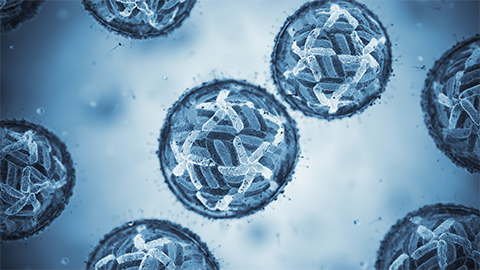Host fatty acids enhance dengue virus infectivity
Mosquito-borne flavivirus infections cause changes in host lipid metabolism. For example, scientists found that the dengue virus, which has no known antiviral treatments, recruits host fatty acid synthase to aid in viral replication. In a recent Journal of Biological Chemistry article, Julia Hehner at Philipps University Marburg and a team in Germany investigated the reliance of various flaviviruses on host fatty acid elongases and desaturases, key enzymes in the biosynthesis of monounsaturated and polyunsaturated fatty acids.

Working with a human hepatic cell line, the authors used RNA interference to individually knock down each fatty acid elongase and desaturase, enzymes that catalyze specific steps for producing fatty acids of different lengths. They exposed the cell lines to dengue, Zika, West Nile, yellow fever and tick-borne encephalitis viruses to measure viral replication. Only dengue virus showed sensitivity to the knockdowns, indicating that this virus relies on fatty acids of specific lengths, while the other viruses can compensate for the loss of one enzyme. Knocking down either the ultra-long-chain elongase ELOVL4 or desaturase FADS2 caused decreased dengue viral titers.
The researchers determined that ELOVL4 knockdown led to slightly lower viral protein levels in the infected cells, possibly signaling ELOVL4 involvement in delaying RNA replication. Surprisingly, the cells lacking FADS2 showed a slight increase in viral protein levels. The authors next measured plaque formation of dengue virus particles produced by the knockdown cell lines and found that cells lacking FADS2 produced viral particles with diminished infectivity. This indicates that FADS2 may promote lipid synthesis necessary for dengue virion assembly.
Future studies will help address the mechanisms behind the observed increase in viral protein levels upon FADS2 knockdown. Further experiments will also help researchers fill in the mechanistic details about how the ultra-long-chain fatty acids produced by ELOVL4 enhance dengue virus infectivity.
Enjoy reading ASBMB Today?
Become a member to receive the print edition four times a year and the digital edition monthly.
Learn moreGet the latest from ASBMB Today
Enter your email address, and we’ll send you a weekly email with recent articles, interviews and more.
Latest in Science
Science highlights or most popular articles

Exploring the link between lipids and longevity
Meng Wang will present her work on metabolism and aging at the ASBMB Annual Meeting, March 7-10, just outside of Washington, D.C.

Defining a ‘crucial gatekeeper’ of lipid metabolism
George Carman receives the Herbert Tabor Research Award at the ASBMB Annual Meeting, March 7–10, just outside of Washington, D.C.

The science of staying strong
Muscles power every movement, but they also tell the story of aging itself. Scientists are uncovering how strength fades, why some species resist it and what lifestyle and molecular clues could help preserve muscle health for life.

Bacteriophage protein could make queso fresco safer
Researchers characterized the structure and function of PlyP100, a bacteriophage protein that shows promise as a food-safe antimicrobial for preventing Listeria monocytogenes growth in fresh cheeses.

Building the blueprint to block HIV
Wesley Sundquist will present his work on the HIV capsid and revolutionary drug, Lenacapavir, at the ASBMB Annual Meeting, March 7–10, in Maryland.

Gut microbes hijack cancer pathway in high-fat diets
Researchers at the Feinstein Institutes for Medical Research found that a high-fat diet increases ammonia-producing bacteria in the gut microbiome of mice, which in turn disrupts TGF-β signaling and promotes colorectal cancer.

